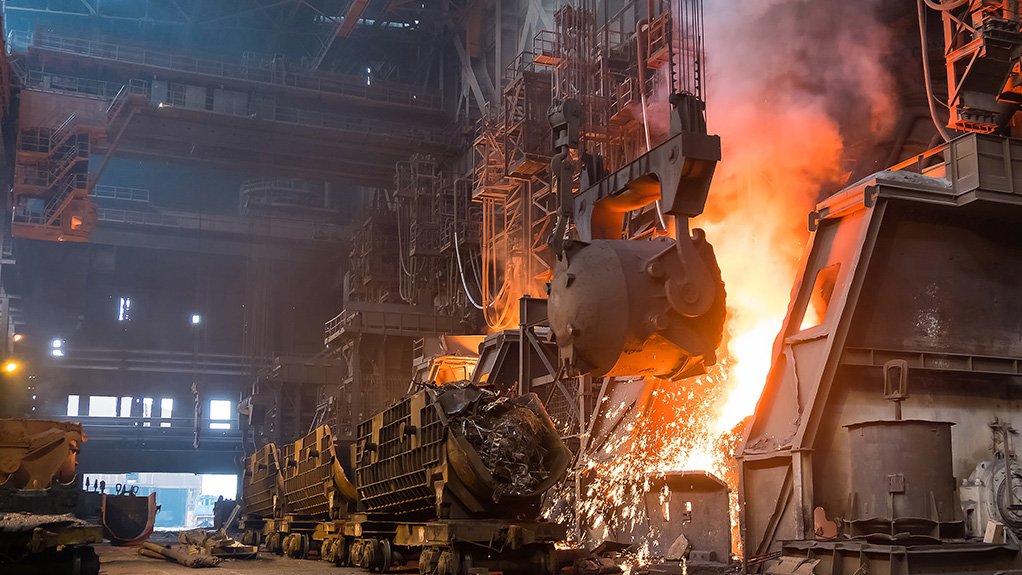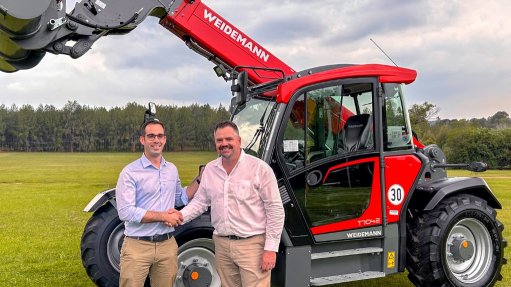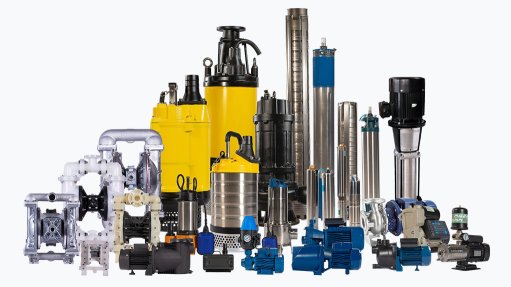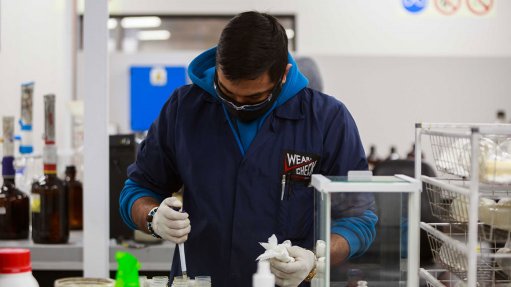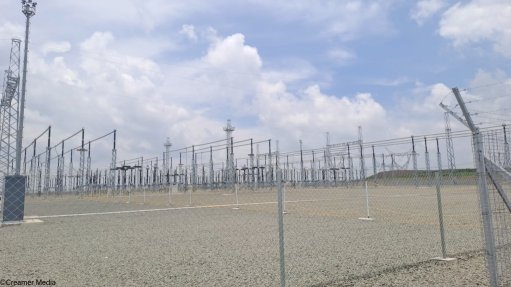Stakeholders propose options for ailing Steel Master Plan
The Portfolio Committee on Trade, Industry and Competition on June 4 held an engagement with stakeholders in the steel industry regarding the progress and outcomes of implementing the Steel Master Plan (SMP), launched in 2021.
A variety of stakeholders provided insight into their experience of the sector and the SMP, with broad consensus that the plan has not been effective, with the sector said to be failing with a myriad of options proposed to mitigate this.
The South African Iron and Steel Institute’s presentation informed that South Africa’s steel production is actually geared up to supply the steel demand from economic growth of over 5% a year.
Last year, the country produced 4.8-million tonnes of crude steel, with net production adjustments putting this figure at 4.4-million tonnes, equivalent to only a small share of global steel production at 0.24%.
Total finished steel output was 39-million tonnes in 2024, of which 800 000 t were exported. The domestic market absorbed 2.9-million tonnes, bolstered by 1.5-million tonnes of imports.
Apparent steel consumption for the year was 4.4-million tonnes.
Concerningly, the sector remains considerably below pre-pandemic levels.
The Institute pointed out that industry’s expectations of the masterplan were for it to resolve many of its challenges.
Working groups for the plan identified priorities with teams set up to work on the 75 deliverables. The central focus of the plan was to enhance the demand side to balance the available supply, retain and grow job opportunities while driving the all-inclusive transformation of the value chain in a six- to 36-month timeframe.
The Institute said that on the supply side, the plan enabled higher-quality long steel and flat steel processes to be developed.
There was also standards revival and enforcement via the National Regulator for Compulsory Specifications and the restructured South African Bureau of Standards; however, this was not fully to the industry’s advantage, which is still struggling with sub-par products.
On the demand side, the plan delivered an industry-funded ‘Steel Fund’ to support the South African Revenue Services’ investigations to curb illicit trade and implement trade measures to half the escalating import trend, detailed.
However, the Institute pointed out that the plan did not meet industry’s expectations, despite these achievements. This is because imports are still at “unacceptable” levels in the wake of a slow domestic market.
Imports of primary steel stand at 36% of apparent steel consumption, with 73% originating from China, leaving only about 2.8-million tonnes of domestic supply.
The Institute averred that the aggravating factor stripping down domestic supply is the current very slow activity levels in the manufacturing sector.
Moreover, value-added product imports also showed an “alarming” 25% year-on-year increase.
Considering the state of the market and to mitigate against further harm, the Institute is calling for the imposition of definitive duties expeditiously, requiring the International Trade Administration Commission of South Africa (Itac) and the Department of Trade, Industry and Competition (dtic) to promptly implement measures to prevent any additional adverse effects on the domestic industry.
The Institute also pointed out that market access into Africa is compromised, which must be accounted for in the Africa Continental Free Trade Agreement, which it said should include countervailing actions against the Dinson steel mill, in Zimbabwe.
It also called for a focus on compulsory standards, managing illicit trade and implementing the proposed import surveillance system.
Matters that need to be resolved include beneficiation to the advantage of the domestic market, dealing with global competition, high production costs, infrastructure and logistics and environmental regulations.
The Steel and Engineering Industries Federation of Southern Africa (Seifsa) said the concept of the SMP remains sound; however, execution is the issue, with over 20 workstreams and 73 deliverables showing a lack of focus.
It said there were some successes, but the slow pace of reform caused the disillusionment of many stakeholders. The country’s steel industry therefore remains fragmented and shows little signs of recovery, Seifsa said.
It called for a new approach, namely, crafting a Strategic Agreement for Impact between government and the steel and engineering sector, with a singular, measurable objective, against which all policy instruments and initiatives can be aligned.
Seifsa also advocated for streamlining efforts into three focused workstreams of industrial policy, demand creation and financing.
The industrial policy workstream must aim to establish a coherent framework that balances competing interests across the value chain, from upstream primary producers to downstream manufacturers, Seifsa said.
The demand creation workstream should be tasked with unlocking catalytic projects that stimulate consumption of domestically produced steel and fabricated products, it emphasised, while the financing workstream must address the chronic undercapitalisation of the sector.
Seifsa also called for the approach to policy to be shifted from punitive to incentive-based mechanisms.
It added that government must lead a national policy alignment drive.
Seifsa further indicated the need to reaffirm the strategic importance of the steel and engineering sector to South Africa’s long-term economic prospects.
The International Steel Fabricators of South Africa said the SMP is not responsible for the current woes of the industry, as it was proposed as a remedy for an industry starting to fail after the first decade of this century.
However, it concurred that the plan has failed in its main objectives, with the industry in general continuing to fail and volumes still dropping, exports decreasing, and the de-industrialisation trend continuing.
The organisation attributed the failure mainly to the SMP not recognising that the industry only services existing demand and has extremely limited influence on creating any demand.
The SMP therefore continued the trend of focusing on upstream steelmaking rather than first focusing on the demand placed on downstream manufacturing, where more than 90% of employment occurs, the entity pointed out.
Moving forward, it said the next five years must focus on survival rather than growth, with the industry in “crisis”.
There is also a need to identify which value-added steel products can be realistically manufactured in the country, and what should rather be imported from elsewhere.
The SMP should also first tackle a few critical issues for survival, it said.
The Metal Recyclers Association, meanwhile, said the SMP deliberately excluded scrap recyclers associations, but included the scrap consumers, resulting in policies which directly harm the recycling and scrap generating sector.
It called against putting more money into producing more steel in mini-mills, when there is currently too much steel in the market. It said this overcapitalisation is showcased in the fact that for the first four months of the year, 395 729 t of ferrous billets and ingots were approved for export by Itac.
The association said the SMP has “created an arbitrage”, where scrap generators transfer R8.5-billion to the mini-mills, which then create basic billet and export these without paying an export duty.
It said that whatever form the SMP takes moving forward, there should be fair representation on its oversight committee, with the full value chain accounted for, and associations rather than companies doing this.
On a more positive note, the Steel Export Association outlined progress made in implementing the SMP as including the establishment of six focus areas for implementation with working groups; a Steel Fund Board being established; a Local Content and Compliance Unit established with work conducted to tackle the escalation of illicit/illegal trade and opportunities identified for localisation; Steel Master Plan workstreams with team leaders were established and series of meetings held; there was a dtic review of steel pipes, pipe fittings and pipe specials designation including other steel products; and there was a review of the tariff structure and investigation into the possible introduction of an import surveillance system.
However, despite this, lessons learnt from the implementation process include that the SMP’s industrial policy framework is not prescriptive and instructive to steel supply chain stakeholders.
The association pointed out that contrary to the SMP’s goals, policy is being implemented in a fragmented manner, with a short-term view and with pockets of industry being pitted against each other.
The Recycling Association of South Africa said that the current price preference system (PPS) and export duty policies are counterproductive, with these undermining job creation, environmental sustainability and economic growth.
It called for the removal of all policy instruments and/or aspects of these that disincentivise the recovery of recycling of scrap metal; a re-evaluation of the PPS discount formula and it administration; implementation of policies that incentivise fair and free trade in the metals recycling sector; and stimulating the supply of secondary raw materials to the country’s manufacturing sector.
Article Enquiry
Email Article
Save Article
Feedback
To advertise email advertising@creamermedia.co.za or click here
Comments
Press Office
Announcements
What's On
Subscribe to improve your user experience...
Option 1 (equivalent of R125 a month):
Receive a weekly copy of Creamer Media's Engineering News & Mining Weekly magazine
(print copy for those in South Africa and e-magazine for those outside of South Africa)
Receive daily email newsletters
Access to full search results
Access archive of magazine back copies
Access to Projects in Progress
Access to ONE Research Report of your choice in PDF format
Option 2 (equivalent of R375 a month):
All benefits from Option 1
PLUS
Access to Creamer Media's Research Channel Africa for ALL Research Reports, in PDF format, on various industrial and mining sectors
including Electricity; Water; Energy Transition; Hydrogen; Roads, Rail and Ports; Coal; Gold; Platinum; Battery Metals; etc.
Already a subscriber?
Forgotten your password?
Receive weekly copy of Creamer Media's Engineering News & Mining Weekly magazine (print copy for those in South Africa and e-magazine for those outside of South Africa)
➕
Recieve daily email newsletters
➕
Access to full search results
➕
Access archive of magazine back copies
➕
Access to Projects in Progress
➕
Access to ONE Research Report of your choice in PDF format
RESEARCH CHANNEL AFRICA
R4500 (equivalent of R375 a month)
SUBSCRIBEAll benefits from Option 1
➕
Access to Creamer Media's Research Channel Africa for ALL Research Reports on various industrial and mining sectors, in PDF format, including on:
Electricity
➕
Water
➕
Energy Transition
➕
Hydrogen
➕
Roads, Rail and Ports
➕
Coal
➕
Gold
➕
Platinum
➕
Battery Metals
➕
etc.
Receive all benefits from Option 1 or Option 2 delivered to numerous people at your company
➕
Multiple User names and Passwords for simultaneous log-ins
➕
Intranet integration access to all in your organisation



